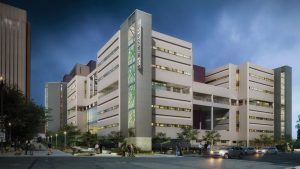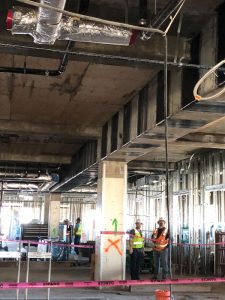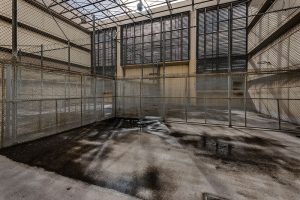Formerly the Madison Street Jail, constructed in 1985, the 225 W. Madison project in Phoenix provided an opportunity to resurrect a decommissioned jail facility and re-purpose it through adaptive re-use as a Class A office building. Maricopa County, the facility owner, chose to re-use and adapt the existing building, resulting in approximately $70M in savings. The 278,775-square-foot building project completely transformed the jail into an open workspace. This was accomplished by enhancing the structural integrity of the original cast-in-place concrete structure, which also serves as the exterior skin. DLR Group provided planning, architecture, structural engineering, MEP engineering, interiors, and construction administration services.
The design challenge was to transform a secure, closed, and fortified structure designed to separate individuals from society and completely reinvent it as an open, welcoming workspace with daylight and views. Other firms assessed the building, and the recommendation was to “tear it down.” Instead, DLR Group took a more creative approach… reuse! By not tearing the space down, the project reused 2.1 million pounds of steel and saved 65 million extra pounds of concrete (16,633 cubic yards) from being sent to the landfill.
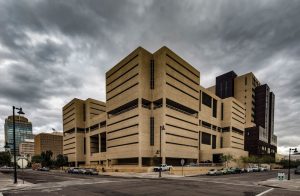
Project overview before – Adaptive reuse
at 225 W. Madison, formerly Madison Street Jail in Phoenix, AZ.
The structural team was tasked with designing the rehabilitation of the Madison Street Jail into an office building. The re-designed building offers modern offices with panoramic views, a bridge to connect to the adjacent courthouse, and an outdoor rooftop garden located on the 5th floor, transforming the 34-year-old building into something that brings “a breath of fresh air” to the area.
What drove the creativity of the structural engineering team was the desire for an integrated, highly useful, open space for Maricopa County. From a code perspective, the project changed the occupancy use of the building, which in turn required evaluating the loading for the new occupancy.
Since the mezzanine was demolished and cell walls, beams, and slab were removed, this left unbraced columns in the open space. The design analysis involved recreating the entire structure of the existing building in analytical models, ensuring each beam and column was strong enough to handle the new loads. All columns, beams, and slabs that did not meet the load requirements were reinforced with carbon fiber or traditional steel methods.
The existing building had 6-inch-high slit windows at a sill height of 7½ feet that provided no views and very little natural light. This challenge was solved by opening-up the concrete spandrel panels to 2½ feet high throughout the complete perimeter of the building. That was just the first step to bring in the light. Since this would leave the window height too high to be useful to look out (5½ feet), a two-foot-high access floor was installed. This dual approach of window height adjustment with reinforcement and floor height adjustment allows office workers to view the city out their window while sitting at their desks. These two concepts were critical to making this project feasible and saving the building from the wrecking ball.
Maricopa County attorneys needed access from the adjacent South Courts Tower to the adjacent courthouse. A pedestrian walkway bridge that connected the two buildings was necessary. County attorneys no longer have to walk blocks from leased offices to the courthouse. The new pedestrian bridge will connect 225 W. Madison with the Superior Courts Complex at the court level, not only saving time and money but improving staff security. An elevation change between buildings required a built-up, sloped concrete detail. The structural systems of each building required a series of expansion joints to act independently and avoid adding lateral load to the new building or the South Courts Tower. The slab-on-metal deck was stepped across an expansion joint. A concrete slab over geofoam created the sloped walkway. Part of the bridge is on top of an existing pedestrian walkway. Inside the South Courts Tower, an atrium opening was infilled to provide a landing and walkway from the new bridge.
Carbon fiber wrapped beams, columns, and slabs were used to meet structural requirements. The carbon fiber reinforced polymer wrap improved the existing strength of the cast-in-place concrete members. One of the specific challenges for the design occurred when a column needed to be reinforced but was locked in by an exterior wall. To accomplish a full wrap for force transfer and adequate reinforcement, embedded ties were used to anchor through the wall and connect to more carbon fiber wrap on the other side. This allowed for full reinforcement even though the column section was not clear or open all the way around.
The carbon fiber was less labor-intensive than traditional steel reinforcement methods. Although traditional steel reinforcement methods were used, a large percentage of reinforcement was achieved by carbon fiber. DLR Group used special carbon fiber reinforcement at concrete beam-to-column connections. The reinforcement was used to increase the moment capacity of the connection. Special carbon fibers were bonded together and adhesive-anchored into the column, and then splayed about the top of the concrete beam where they were attached more conventionally.
The old interior stairs were removed to utilize the entire interior floor space for usable square footage. The most prominent exterior feature is the exterior steel braced framed stair towers. The towers are supported by a concrete retaining wall and include piers and mat foundation on deep drilled shafts.
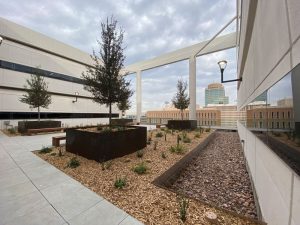
Implemented carbon reinforcement and traditional steel reinforcement methods to accommodate load that is double the existing design.
The heaviest load in the new occupancy of the building is a rooftop garden consisting of planter areas, large trees, and built-up soil. Previously, this was only a lightly-used inmate recreational area. The increased load difference between these two occupancies required steel beam reinforcement to shorten the span of the existing slab, as well as carbon fiber reinforcement for some of the slabs and the columns below the rooftop level.
The highest form of true sustainability is to re-purpose an existing facility. The Madison Street Adaptive Reuse project is evidence of the environmental and societal benefits creativity and structural ingenuity can provide.■
Project Team
Owner: Maricopa County Facilities Management Department (FMD)
Architect of Record: DLR Group
Contractor: Layton Construction
Structural Software: Structural Systems, Ram Concept, RAM Connection, RAM Elements, RAM SBeam, RetainPro, Simpson Strong-tie Anchor Designer, SP Beam, SAP 2000

